新型羧酸配体与过渡金属配合物合成及结构研究
过渡金属有机化合物的合成与催化应用
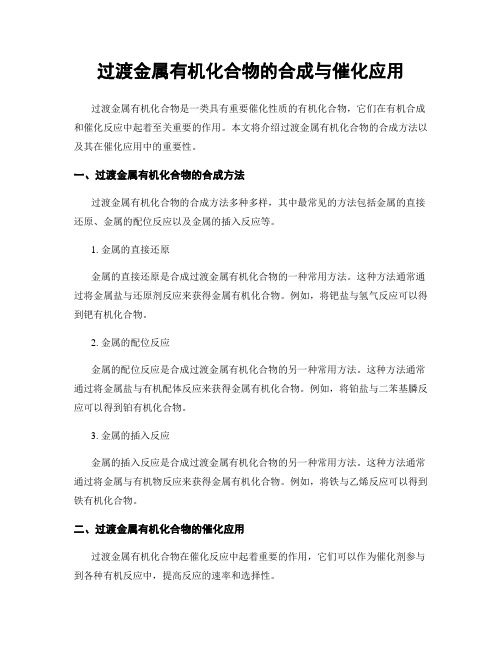
过渡金属有机化合物的合成与催化应用过渡金属有机化合物是一类具有重要催化性质的有机化合物,它们在有机合成和催化反应中起着至关重要的作用。
本文将介绍过渡金属有机化合物的合成方法以及其在催化应用中的重要性。
一、过渡金属有机化合物的合成方法过渡金属有机化合物的合成方法多种多样,其中最常见的方法包括金属的直接还原、金属的配位反应以及金属的插入反应等。
1. 金属的直接还原金属的直接还原是合成过渡金属有机化合物的一种常用方法。
这种方法通常通过将金属盐与还原剂反应来获得金属有机化合物。
例如,将钯盐与氢气反应可以得到钯有机化合物。
2. 金属的配位反应金属的配位反应是合成过渡金属有机化合物的另一种常用方法。
这种方法通常通过将金属盐与有机配体反应来获得金属有机化合物。
例如,将铂盐与二苯基膦反应可以得到铂有机化合物。
3. 金属的插入反应金属的插入反应是合成过渡金属有机化合物的另一种常用方法。
这种方法通常通过将金属与有机物反应来获得金属有机化合物。
例如,将铁与乙烯反应可以得到铁有机化合物。
二、过渡金属有机化合物的催化应用过渡金属有机化合物在催化反应中起着重要的作用,它们可以作为催化剂参与到各种有机反应中,提高反应的速率和选择性。
1. 氢化反应过渡金属有机化合物在氢化反应中起着重要的催化作用。
它们可以作为催化剂催化有机物的氢化反应,将不饱和化合物转化为饱和化合物。
例如,铂有机化合物可以催化烯烃的氢化反应,将烯烃转化为烷烃。
2. 氧化反应过渡金属有机化合物在氧化反应中也起着重要的催化作用。
它们可以作为催化剂催化有机物的氧化反应,将有机物转化为氧化产物。
例如,钼有机化合物可以催化醇的氧化反应,将醇转化为醛或酮。
3. 羰基化反应过渡金属有机化合物在羰基化反应中也起着重要的催化作用。
它们可以作为催化剂催化有机物的羰基化反应,将有机物转化为羰基化合物。
例如,钯有机化合物可以催化烯烃的羰基化反应,将烯烃转化为酮。
综上所述,过渡金属有机化合物的合成与催化应用是有机合成和催化领域中的重要研究方向。
羧酸和铜离子配位shuiningjiao水凝胶
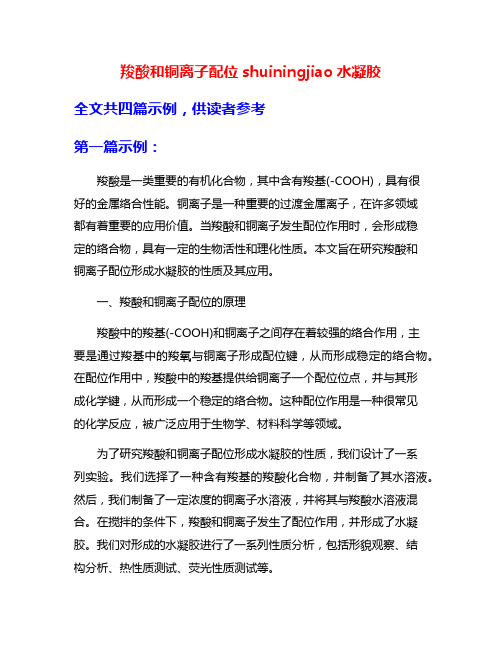
羧酸和铜离子配位shuiningjiao水凝胶全文共四篇示例,供读者参考第一篇示例:羧酸是一类重要的有机化合物,其中含有羧基(-COOH),具有很好的金属络合性能。
铜离子是一种重要的过渡金属离子,在许多领域都有着重要的应用价值。
当羧酸和铜离子发生配位作用时,会形成稳定的络合物,具有一定的生物活性和理化性质。
本文旨在研究羧酸和铜离子配位形成水凝胶的性质及其应用。
一、羧酸和铜离子配位的原理羧酸中的羧基(-COOH)和铜离子之间存在着较强的络合作用,主要是通过羧基中的羧氧与铜离子形成配位键,从而形成稳定的络合物。
在配位作用中,羧酸中的羧基提供给铜离子一个配位位点,并与其形成化学键,从而形成一个稳定的络合物。
这种配位作用是一种很常见的化学反应,被广泛应用于生物学、材料科学等领域。
为了研究羧酸和铜离子配位形成水凝胶的性质,我们设计了一系列实验。
我们选择了一种含有羧基的羧酸化合物,并制备了其水溶液。
然后,我们制备了一定浓度的铜离子水溶液,并将其与羧酸水溶液混合。
在搅拌的条件下,羧酸和铜离子发生了配位作用,并形成了水凝胶。
我们对形成的水凝胶进行了一系列性质分析,包括形貌观察、结构分析、热性质测试、荧光性质测试等。
通过实验,我们发现羧酸和铜离子配位形成的水凝胶具有以下几个显著的性质:1. 结构稳定性:羧酸和铜离子配位形成的水凝胶具有很好的结构稳定性,能够在较宽的温度范围内保持其凝胶状态。
2. 荧光性质:羧酸和铜离子配位形成的水凝胶在紫外光照射下显示出荧光性质,具有一定的生物标记应用潜力。
4. 形貌观察:羧酸和铜离子配位形成的水凝胶在显微镜下呈现出均匀的网状结构,具有较好的微观形貌。
通过以上性质分析,我们可以得出结论,羧酸和铜离子配位形成的水凝胶具有良好的性质,具有广泛的应用潜力。
1. 生物医学应用:羧酸和铜离子配位形成的水凝胶具有一定的生物活性,可作为药物传递载体或生物医用材料。
2. 环境保护应用:羧酸和铜离子配位形成的水凝胶具有较好的吸附性能,可用于废水处理或重金属离子去除等环境保护领域。
基于邻菲啰啉衍生物配体构筑的配位聚合物的结构及性质研究

摘 要本论文旨在设计开发结构新颖并具有潜在应用的新型配位聚合物(Coordination Polymers, CPs),以2-(2-羧基苯基)咪唑并[4,5-f][1,10]邻菲啰啉(2-HNCP)为主配体,简单的芳香羧酸为辅助配体,过渡金属、主族金属为中心金属离子,利用水热合成技术制备出9个CPs。
通过单晶X-射线衍射、元素分析、红外光谱等手段对CPs的晶体结构进行了表征。
此外,利用热重分析和气体吸附分析对热稳定性及气体吸附等性质进行了初步研究,并比较CPs间的结构及性质差异。
主要内容为:1. 以2-HNCP为主配体,羧酸配体[吡啶-4-羧酸(4-Hpyc)、1,4-对苯二甲酸(1,4-H2BDC)、2-羟基对苯二甲酸(HO-H2BDC)及2-氨基对苯二甲酸(H2N-H2BDC)]为辅助配体,分别与主族金属离子Pb2+配位,成功合成了5个CPs:[Pb(2-NCP)(4-pyc)]n (1)、[Pb2(2-NCP)2(H2N-BDC)]n·2nH2O (2)、[Pb2(2-NCP)2(H2N-BDC)]n(3)、[Pb2(2-NCP)2(1,4-BDC)]n (4)和[Pb2(2-NCP)2(HO-BDC)]n (5)。
结构分析表明:CP 1是一维链状结构,通过π-π堆积作用形成二维及三维的超分子结构;CP 2为二维层状结构。
CPs 3-5结构相似,均为三维结构。
对CPs 1-5的热稳定性和气体吸附性能进行了探究,实验结果表明CPs 1-5均具有较好的热稳定性,CPs 1-5对CO2具有一定的选择吸附性能。
此外,研究了CPs 1-5在可见光条件下对有机染料的光催化性能,其中CP 3对亚甲基蓝(MB)具有良好的降解效果。
2. 以2-HNCP为主配体,羧酸配体[2,4-吡啶二羧酸(2,4-H2pyc)、1,4-H2BDC及HO-H2BDC]为辅助配体,分别与过渡金属离子Mn2+配位,成功合成了4个CPs:[Mn(2-NCP)2]n (6)、[Mn2(2-NCP)2(2,4-pyc)]n·2nH2O (7)、[Mn2(2-NCP)2(1,4-BDC)]n (8)、[Mn2(2-NCP)2(HO-BDC)]n(9)。
基于金属-羧酸根配位的聚异戊二烯弹性体的合成与表征
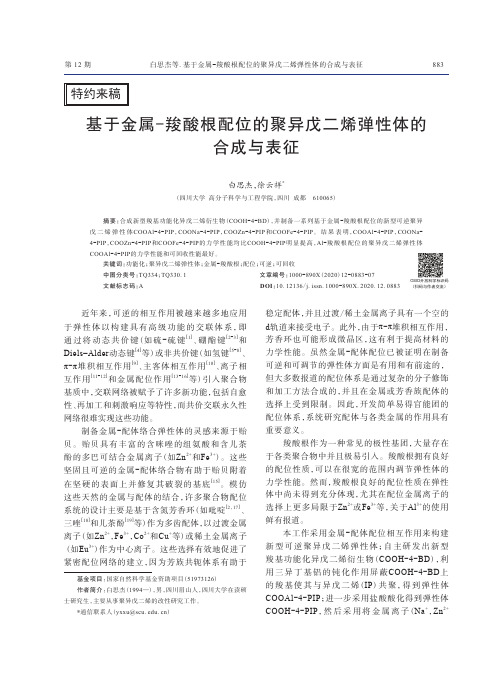
基于金属-羧酸根配位的聚异戊二烯弹性体的合成与表征白思杰,徐云祥*(四川大学高分子科学与工程学院,四川成都610065)摘要:合成新型羧基功能化异戊二烯衍生物(COOH-4-BD),并制备一系列基于金属-羧酸根配位的新型可逆聚异戊二烯弹性体COOAl-4-PIP,COONa-4-PIP,COOZn-4-PIP和COOFe-4-PIP。
结果表明,COOAl-4-PIP,COONa-4-PIP,COOZn-4-PIP和COOFe-4-PIP的力学性能均比COOH-4-PIP明显提高,Al-羧酸根配位的聚异戊二烯弹性体COOAl-4-PIP的力学性能和可回收性能最好。
关键词:功能化;聚异戊二烯弹性体;金属-羧酸根;配位;可逆;可回收中图分类号:TQ334;TQ330.1 文章编号:1000-890X(2020)12-0883-07文献标志码:A DOI:10.12136/j.issn.1000-890X.2020.12.0883基金项目:国家自然科学基金资助项目(51973126)作者简介:白思杰(1994—),男,四川眉山人,四川大学在读硕士研究生,主要从事聚异戊二烯的改性研究工作。
*通信联系人(yxxu@)OSID开放科学标识码(扫码与作者交流)近年来,可逆的相互作用被越来越多地应用于弹性体以构建具有高级功能的交联体系,即通过将动态共价键(如硫-硫键[1]、硼酯键[2-3]和Diels–Alder动态键[4]等)或非共价键(如氢键[5-8]、π-π堆积相互作用[9]、主客体相互作用[10]、离子相互作用[11-12]和金属配位作用[13-16]等)引入聚合物基质中,交联网络被赋予了许多新功能,包括自愈性、再加工和刺激响应等特性,而共价交联永久性网络很难实现这些功能。
制备金属-配体络合弹性体的灵感来源于贻贝。
贻贝具有丰富的含咪唑的组氨酸和含儿茶酚的多巴可结合金属离子(如Zn2+和Fe3+)。
这些坚固且可逆的金属-配体络合物有助于贻贝附着在坚硬的表面上并修复其破裂的基底[15]。
含N、O类有机配体的金属配合物的合成、晶体结构及质研究硕士学位

含N、O类有机配体的金属配合物的合成、晶体结构及质研究硕士学位分类号(06) 密级公开___UDC ____ 编号___________硕士研究生学位论文题目:含N、O类有机配体的金属配合物的合成、晶体结构及性质研究学院(所、中心)化学科学与工程学院专业名称分析化学云南大学硕士研究生学位论文含N、O类有机配体的金属配合物的合成、晶体结构及性质研究Study on synthesis, crystal structure and properties of metal complexes with organic ligands containing nitrogen or oxygen atom云南大学化学科学与工程学院2011年10月独创性声明本人声明所呈交的论文是我个人在导师指导下进行的研究工作及取得的研究成果。
除了文中特别加以标注和致谢的地方外,论文中不包含其他人或集体已经发表或撰写过的研究成果,对本文的研究做出贡献的集体和个人均已在论文中作了明确的说明并表示了谢意。
研究生签名:日期:论文使用和授权说明本人完全了解云南大学有关保留、使用学位论文的规定,即:学校有权保留并向国家有关部门或机构送交学位论文和论文电子版;允许论文被查阅或借阅;学校可以公布论文的全部或部分内容,可以采用影印、缩印或其他复制手段保存论文。
(保密的论文在解密后应遵循此规定)研究生签名:导师签名:日期:…………………………………………………………………本人及导师同意将学位论文提交至清华大学“中国学术期刊(光盘版)电子杂志社”进行电子和网络出版,并编入CNKI系列数据库,传播本学位论文的全部或部分内容,同意按《中国优秀博硕士学位论文全文数据库出版章程》规定享受相关权益。
研究生签名:导师签名:日期:毕业设计(论文)原创性声明和使用授权说明原创性声明本人郑重承诺:所呈交的毕业设计(论文),是我个人在指导教师的指导下进行的研究工作及取得的成果。
《基于V-型半刚性多羧酸配体构筑新型金属配位化合物的研究》北京科技大学: 刘晨曦;邓玉豪;姜健壮

基于V-型半刚性多羧酸配体构筑新型金属配位化合物的研究刘晨曦1邓玉豪1姜健壮1*(1.北京科技大学化学与生物工程学院北京100083)摘要近年来,含羧酸与含氮杂环配体金属有机骨架(MOFs,即金属有机配位聚合物)发展迅速,已成为材料化学领域的一个研究的热点,得到了学术界和工业界的广泛关注。
它不仅拓扑结构丰富,而且拥有比传统的分子筛等多孔材料更高的比表面积,同时凭借其结构的可剪裁性、可设计性、孔道易调控性、易功能化等特性,在气体存储、选择性吸附和分离、荧光、电磁学、手性拆分及催化等领域具有诱人的应用前景。
本实验选择了过渡金属(Zn,Co,Ni,Cu,Cd),多羧酸及其他多种含有氮原子的配体组装出一系列具有新颖结构的金属有机配位聚合物,并利用X-ray 单晶衍射手段测定其晶体结构。
关键词:金属有机配合物;晶体结构;V-型半刚性多羧酸配体AbstractIn recent years,containing carboxylic acid and heterocyclic ligand complex (MOFs,metal-organic coordination polymers)development rapidly has become a research focus of the field of materials chemistry.In accordance with the principle of crystal engineering,the method of synthesis of crystalline materials in general,selects a specific ligand configuration of the central metal ion and functional organic ligands. In this article,we have selected a transition metal or rare earth metals,and carboxylic*通讯联系人:E-mail:jianzhuang@acids and nitrogen-containing ligands,,the synthesis of nine new functional coordination polymers under hydrothermal and solve thermal synthesis method. Crystal structure analysis,elemental analysis and IR,TGA,and some compounds of the fluorescence properties are characterized.In summary,the transition metal ions(Zn,Co,Ni,Cu,Cd)were selected as templates,and polycarboxylic acids were chosen as linkers to construct metal-organic coordination polymers with novel and fascinating crystal structures.These complexes were characterized by single-crystal X-ray diffraction.Keywords:metal-organic coordination polymer;crystal structure;V-shaped semirigid multicarboxylate ligands.目录摘要 (1)Abstract (1)配体分子符号对照图 (4)1文献综述 (5)1.1V-型半刚性构筑的化合物的简介 (5)1.2金属-有机配合物的合成方法和影响因素 (6)1.2.1金属-有机配合物的合成方法 (6)1.2.2金属-有机配合物合成影响因素 (7)2实验部分 (9)2.1试剂以及实验用品 (9)2.1.1试剂 (9)2.2.2主要仪器 (10)2.2V-型半刚性多羧酸配的合成[18-22] (10)2.3辅助配体的合成 (11)2.4晶体合成 (11)2.4.1[Zn3(L1)2(4,4'-bpy)2]n.(H2O)2n(1)的制备 (11)2.4.2[Zn3(L2)2(4,4'-bpy)(H2O)2]n.(H2O)2n(2)的制备 (12)2.4.3[Zn3(L3)2(4,4'-bpy)2(H2O)4]n.(H2O)6n(3)的制备 (12)2.4.4[Zn3(L1)2(BIX)3]n.(H2O)7n(4)的制备 (12)2.4.5[Zn3(L2)2(BIX)3]n.(H2O)2n(5)的制备 (12)2.4.6[Zn3(HL3)2(bix)2]n(6)的制备 (13)2.5显微镜下晶体形状 (13)2.6晶体表征 (14)2.6.1热重分析 (14)2.6.2晶体结构测定 (14)2.6.3荧光分析.................................................................................................................203小结...............................................................................................................................................21参考文献...........................................................................................................................................22配体分子符号对照图O COOHHOOCCOOHH 3L 1H 3L2H 3L 3BIXH 4L 1H 4L 2H4L3H6L1文献综述1.1V-型半刚性构筑的化合物的简介近年来,功能型配位聚合物由于其结构上的分子美感和独特的物理化学性质已经成为晶体工程学和材料科学领域中一个重要的前沿的研究领域。
基于羧酸配体的金属有机配合物设计与组装.doc

重庆大学本科学生毕业设计(论文)基于羧酸配体的金属有机配合物设计与组装学生:李洪江学号:20116650指导教师:龚云专业:应用化学重庆大学化学化工学院二O一五年六月Graduation Design(Thesis) of Chongqing UniversityDesign and assembly of metal organic complexes based on carboxylic ligandUndergraduate: Li HongjiangSupervisor: Prof. Gong YunMajor: Applied ChemistryChemistry and Chemical Engineering Chongqing UniversityJune 2015中文摘要金属-有机骨架材料(MOFs)是以金属离子或金属簇作为连接点,以有机配体作为连接体构成的无限延伸的网络结构,在储能、催化以及分离等方面都起到了广泛的作用,可能充当分子识别、选择催化、超高纯度分离、光致变色、生物传导、光电等新型材料。
由于金属-有机骨架材料(MOFs)具有结晶度高、纯度高、成本低,结构可控等一系列优点,它近些年来受到了全世界材料学研究者们的广泛关注。
本文采用水热法,利用4-(4-氧基-1-吡啶) 邻苯二甲酸(H2L)与Cd2+,采用水热法合成了两种金属-有机骨架配合物:CdL(H2O)2 (1)和C dL (2),并对配合物1和2的结构进行了单晶X射线衍射表征。
在配合物1和2中,配体L2-采用不同的配位方式,但是这两个配合物都是二维层状结构。
粉末X射线衍射数据表明得到的配合物1是纯相样品。
本文还对配合物1进行了紫外可见光谱和热稳定性测试。
关键词:金属-有机骨架,水热合成,含氮羧酸,晶体结构ABSTRACTMetal-organic frameworks (MOFs) possess infinite extensive network in which metal ions or metal cluster act as nodes and organic ligands function as linkers, they play important roles in storing energy, catalyzing and separation and they may have potential applications in molecular recognition, selective catalysis, separation with ultra-high purity, photochromism, biology conduction and photoelectric field. Because MOFs have a serial of advantages such as high crystallinity, high purity, low cost and adjustable structures, they have drawn extensive attention by the researchers all over the world.In this paper, using 4-(4-oxypyridinium-1-yl)phthalic acid (H2L) and Cd2+, two MOFs formulated as CdL(H2O)2 (1) and C dL (2) have been synthesized hydrothermally. The two MOFs have been structurally characterized by single crystal X-ray diffraction. In complexes 1and 2, L2- ligand adopts different coordination modes, but the two complexes are two dimensional (2D) layer structures. Powder X-ray diffraction data indicates the bulk sample of complex 1is in pure phase. The UV-vis spectrum and thermally stability of complex 1 have also been measured.Key words:MOFs, hydrothermal synthesis, Carboxylic ligand containing N atom, crystal structure目录中文摘要 (I)ABSTRACT (II)1 绪论 (1)1.1 金属-有机骨架配合物的简介 (1)1.2 金属-有机骨架配合物的分类 (1)1.2.1 含氮杂环有机配体构筑MOFs (2)1.2.2 羧酸有机配体构筑MOFs (2)1.2.3 含氮杂环配体与羧酸有机配体构筑MOFs (2)1.2.4 含膦酸配体构筑MOFs (2)1.3 金属-有机骨架配合物的合成方法 (3)1.3.1 溶液挥发法 (3)1.3.2 界面扩散法 (3)1.3.3 熔融盐法 (3)1.3.4 水热法和溶剂热法 (4)1.4 金属有机配合物的应用 (5)1.4.1金属有机配合物在光学材料方面的研究 (5)1.4.2 金属有机配合物在磁性材料方面的研究 (5)1.4.3 金属有机配合物在微孔材料方面的研究 (6)1.4.4 金属有机配合物在催化反应中的研究 (7)1.4.5金属有机配位聚合物在超分子方面的研究 (7)1.5 本课题的选题目的、意义以及主要的研究方法 (8)1.5.1 本课题选题的目的和意义 (8)1.5.2 本课题的主要研究内容 (8)1.6 本论文主要使用的仪器 (9)2 两种配合物的合成 (10)2.1 实验部分 (10)2.1.1 试剂和仪器 (10)2.1.2 配合物CdL(H2O)2 (1)的合成 (10)2.1.3 配合物CdL (2)的合成 (10)2.2 配合物1与配合物2的合成区别 (11)2.3 实验中拍摄配合物实体照片的简要分析 (11)3 两种配合物的结构、参数和性质 (12)3.1 配合物CdL(H2O)2 (1)的配位方式和结构 (12)3.1.1 配合物1的配位方式 (12)3.1.2 配合物1的结构 (13)3.1.3 配合物1的相关数据 (14)3.1.4 配合物1的键长与键角 (15)3.2 配合物1的性质 (16)3.2.1 配合物1的红外光谱 (16)3.2.2 配合物1的热重分析 (17)3.3 配合物CdL (2)的配位方式和结构 (18)3.3.1 配合物2的配位方式 (18)3.3.2 配合物2的结构 (19)3.3.3 配合物2的相关数据 (20)3.3.4 配合物2的键长与键角 (21)3.4 两种配合物的紫外光谱 (22)3.4.1 紫外-可见吸收光谱 (22)4 结论与展望 (24)4.1 结论 (24)4.2 展望 (24)参考文献 (25)1 绪论1.1 金属-有机骨架配合物的简介金属-有机骨架配合物材料是主要由含氮或者含氧的有机配体与一些过渡金属离子连接从而形成可能拥有网状孔隙结构骨架的材料,我们简称MOFs[1-5]。
基于羧酸类配体的金属有机框架(MOFs)材料的合成及其电化学性能研究
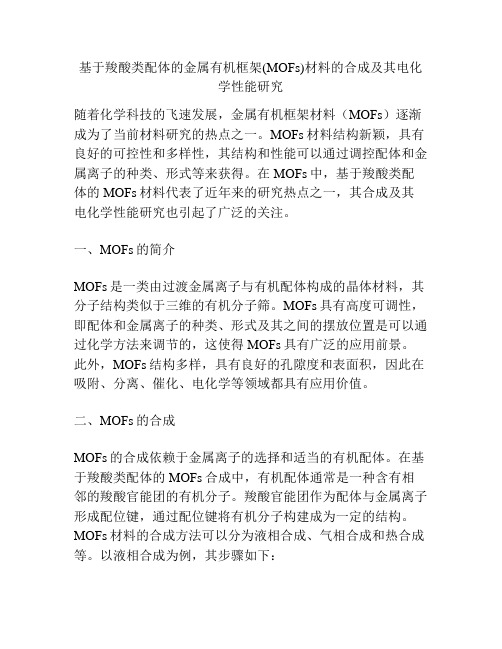
基于羧酸类配体的金属有机框架(MOFs)材料的合成及其电化学性能研究随着化学科技的飞速发展,金属有机框架材料(MOFs)逐渐成为了当前材料研究的热点之一。
MOFs材料结构新颖,具有良好的可控性和多样性,其结构和性能可以通过调控配体和金属离子的种类、形式等来获得。
在MOFs中,基于羧酸类配体的MOFs材料代表了近年来的研究热点之一,其合成及其电化学性能研究也引起了广泛的关注。
一、MOFs的简介MOFs是一类由过渡金属离子与有机配体构成的晶体材料,其分子结构类似于三维的有机分子筛。
MOFs具有高度可调性,即配体和金属离子的种类、形式及其之间的摆放位置是可以通过化学方法来调节的,这使得MOFs具有广泛的应用前景。
此外,MOFs结构多样,具有良好的孔隙度和表面积,因此在吸附、分离、催化、电化学等领域都具有应用价值。
二、MOFs的合成MOFs的合成依赖于金属离子的选择和适当的有机配体。
在基于羧酸类配体的MOFs合成中,有机配体通常是一种含有相邻的羧酸官能团的有机分子。
羧酸官能团作为配体与金属离子形成配位键,通过配位键将有机分子构建成为一定的结构。
MOFs材料的合成方法可以分为液相合成、气相合成和热合成等。
以液相合成为例,其步骤如下:1.将羧酸配体溶于乙醇或水中,调节pH值使配体离子化;2.加入金属离子,形成配位键,产生前驱体;3.在恰当的条件下进行加热或沉淀,形成MOFs晶体。
三、基于羧酸类配体的MOFs材料的电化学性质研究基于羧酸类配体的MOFs材料具有优异的电化学性质,这是其在光电催化、电池等领域发挥作用的必要条件。
1.电容性能MOFs材料通常具有良好的孔隙度和表面积,这种结构特点使得MOFs材料在电容器制作方面有广泛的应用前景。
例如,Copper-based MOFs的电容性能较为突出。
固体金属氧化物和碳基材料通常采用复杂的制备方法,并且有较高的成本,而MOFs材料具有低成本、易合成等优势,因此能够被用于超级电容器的制作和应用。
多羧酸类配体(TPBTECHLT2GTIDADCBP)构筑的配位聚合物的设计、..

多羧酸类配体(tp,btec,H2IDA,debp)构筑的配位聚合物的设计、合成、结构及性质摘要配位聚合物由于结构上的多样性以及在吸附、催化、磁性等新材料领域潜在的应用价值,近年来这一领域的研究成为集基础研究和应用研究于一体的前沿课题。
按照晶体工程的原理,通过选择特定几何构型的中心金属离子和特殊的有机配体可以在一定程度上实现晶态材料的的定向设计和合成,其中,具有螺旋结构的的材料的设计与和合成是目前研究的挑战与热点。
螺旋结构在自然界普遍存在,但是在合成材料中还是比较少见的。
最近,通过配体和金属离子的自组装设计合成具有螺旋结构的的配位聚合物已经取得了很多进展,但是大多数还都是使用含有磷酸,亚磷酸以及氧化物的无机螺旋结构。
本研究采用溶液法、水热法以二元或多元羧酸(对苯二甲酸,均苯四酸,亚氨基二乙酸,4,4’一二羧酸一2,2'-联吡啶,3,3’.二羧酸.2,2’.联吡啶等)为主要的桥联配体与过渡金属Zn2+,cd2+,Cu2+,主族金属Pb2+及稀土金属离子构筑多种配位聚合物,并对它们的晶体结构和性质进行了表征。
本文共分为五部分。
首先概述了配位聚合物的基本概念、研究进展、羧酸类配体构筑的配位聚合物总览以及常用合成方法。
以剐性芳香族多羧酸化合物对苯二甲酸,均苯四酸为配体与具有d10结构的过渡金属在不同条件下形成不同的配合物,并研究了它们的荧光性质,提出许多d旧电子组态的金属,如zrl2+,Cd2+,Cu+,Ar等与对苯二甲酸构成的配位聚合物都表现出明显的荧光性质。
以均苯四酸为桥联配体与Cd”形成三维配位聚合物,该聚合物中有直径为9.3×4.7A的孔道,水分子填充在孔道之中,同时该化合物也有好的荧光性质。
氨基酸类配体是被广泛研究使用的配体,此类配体具有较多的配位点,因其在生物等领域的应用而备受重视。
以柔性的二羧酸一亚氨基二乙酸为配体,邻菲罗啉为第二配体与cu2*形成独立的配合物分子,并且从实验和理论上对该化合物的光谱进行了研究。
双羧酸配合物的制备与性质研究的开题报告

双羧酸配合物的制备与性质研究的开题报告题目:双羧酸配合物的制备与性质研究摘要:本研究旨在通过合成不同的双羧酸配合物,探究其在化学、物理、材料等领域的性质与应用。
首先选取不同的双羧酸化合物为配体,配合过渡金属离子或稀土离子。
通过红外光谱、X射线衍射、热重分析等手段对合成的配合物进行表征,研究其吸附、催化和荧光等性质,以期实现其在环境、催化和生物医药领域的应用。
关键词:双羧酸;配合物;性质;应用正文:1. 研究背景双羧酸是一种含有两个羧基的化合物,具有很好的配位性能,可与过渡金属离子或稀土离子形成配合物,广泛应用于催化、吸附、荧光探针等领域。
近年来,随着环境保护和能源问题的越来越受到人们的关注,双羧酸配合物的研究也越来越受到关注。
2. 研究目的本研究旨在合成不同的双羧酸配合物,探究其在化学、物理、材料等领域的性质与应用,为实现其在环境、催化和生物医药领域的应用提供理论基础和实验依据。
3. 研究内容(1)选择不同的双羧酸化合物作为配体,配合过渡金属离子或稀土离子。
(2)通过红外光谱、X射线衍射、热重分析等手段对合成的配合物进行表征,判断其结构和组成。
(3)研究配合物的吸附、催化和荧光等性质,为其在环境、催化和生物医药领域的应用提供基础研究。
4. 研究方法(1)化学合成法:选择不同的双羧酸化合物和过渡金属离子或稀土离子,以不同的配体和金属离子摩尔比合成不同配合物。
(2)红外光谱、X射线衍射、热重分析法等:使用这些手段对合成的配合物进行光谱、结构和热稳定性等方面的分析。
(3)吸附、催化和荧光等性质测定:通过一系列实验测定分析,研究配合物的吸附、催化和荧光等性质。
5. 研究意义本研究将为双羧酸配合物的应用提供理论基础和实验依据,为环境提供净化、化学反应提供催化剂以及生物医药提供荧光探针等方面的应用提供了可能。
同时,本研究也为类似化合物的研究提供了经验和参考,为该领域的进一步发展提供支撑和借鉴。
金属有机羧酸配合物合成及结构表征

6.3 微生物指标:大肠菌群≤7 个/100ml;致病菌:未检出。
品品质的影响。
参考文献
5.2.3 枸杞添加量对酸奶昔品质的影响。先将枸杞汁 1:1 稀 [1]李正明等.实用果蔬汁生产技术[M].北京:中国轻工业出版社.
释,量取 5 份 100ml 成品的酸奶昔,其中枸杞汁的含量分别为 2012
1ml、2ml、3ml、4ml、5ml,来考察枸杞汁添加量对产品品质的影 [2]邵宁华.果蔬原料学[M].北京:农业出版社.2010
响。
[3]高福成.新型发酵食品[M].北京:中国轻工业出版社.2008
5.2.4 银耳添加量对酸奶昔品质的影响。称取 5 份 100ml 成 [4]李淑敏等.新型乳制品加工[M].北京:中国轻工业出版社.2011
品的酸奶昔,将打浆、离心、过滤之后的银耳液,按照 4ml、8ml、 [5]李冬梅.明胶在乳制品中的应用[J].食品工业.2009
95%
不同的金属离子形成不同的配位结构形式,进而合成不同的配
2.2 配合物的合成
合物,但金属离子的配位受环境的变化而变化,合成偏离原本
称取(0.1203g,0.25mol)间苯三甲酸和(0.1248g,0.5mol)乙酸
结构的配合物。去质子化的羧酸配体与金属离子更易形成高维 镍,将二者溶于乙醇与蒸馏水各 10ml 配好溶剂,匀速搅拌 2 个
之一。
3 配合物结构解析
2 实验部分
对晶体进行 X-射线单晶衍射收集数据的方法分析其结构,
2.1 实验试剂
单晶衍射在 XtaLAB Pro: Kappa dual offset/far 型射 (转下页)
5.2 单因素试验及正交试验
味,酸甜可口。
过渡金属有机催化剂的合成与应用研究

过渡金属有机催化剂的合成与应用研究过渡金属有机催化剂是一种在有机合成中起关键作用的催化剂。
通过催化剂的作用,可以提高反应速率、选择性和收率,从而开辟新的合成路径。
过渡金属有机催化剂的合成与应用研究一直是有机化学领域的热点之一。
在过渡金属有机催化剂的合成中,常用的方法包括金属催化剂的前体化合物的合成和合成后的后修饰。
在前体化合物的合成过程中,有机金属化学合成方法发挥了重要的作用。
例如,常用的配体有磷配体、氮配体和碳配体等。
其中,磷配体是应用最广泛的一种。
它们具有良好的配位性能和可调节的电子性质,可以影响催化剂的反应活性和选择性。
过渡金属有机催化剂的合成后修饰是提高催化剂的效果和稳定性的重要手段。
常见的后修饰方法包括改变配体的结构和功能、引入其他官能团以增强反应催化性能等。
例如,可以通过改变配体的空间位阻、引入电子吸引基团或电子供体基团等方法来控制反应的立体选择性和反应速率。
过渡金属有机催化剂的应用研究是有机合成化学的重要组成部分。
随着催化剂设计和反应条件的优化,越来越多的有机合成反应可以通过过渡金属有机催化剂来实现。
例如,金属催化的C-H键活化反应在有机化学领域引起了广泛关注。
通过催化剂的作用,可以将C-H键转化为C-C、C-N、C-O等键,实现高效、高选择性的合成。
此外,还有金属催化的C-C键活化反应、羰基化反应等也得到了较好的研究。
过渡金属有机催化剂在天然产物合成、药物合成和新材料合成等领域都有重要应用。
然而,过渡金属有机催化剂的合成与应用研究还存在一些挑战。
首先,催化剂的设计和合成是复杂的过程,需要考虑催化剂的活性、选择性、稳定性、毒性等方面的问题。
其次,部分过渡金属催化剂的合成步骤复杂,成本较高。
此外,在一些复杂体系中,催化剂的抗干扰能力也是一个重要的考虑因素。
因此,需要进一步开展硅配体、酸配体等新型配体的设计与合成,以改进催化剂的性能和应用范围。
总之,过渡金属有机催化剂的合成与应用研究是有机化学领域的前沿课题,对于促进有机合成的发展具有重要意义。
《基于多羧酸配体与多氮杂环配体的配位聚合物的合成、结构及性能研究》范文
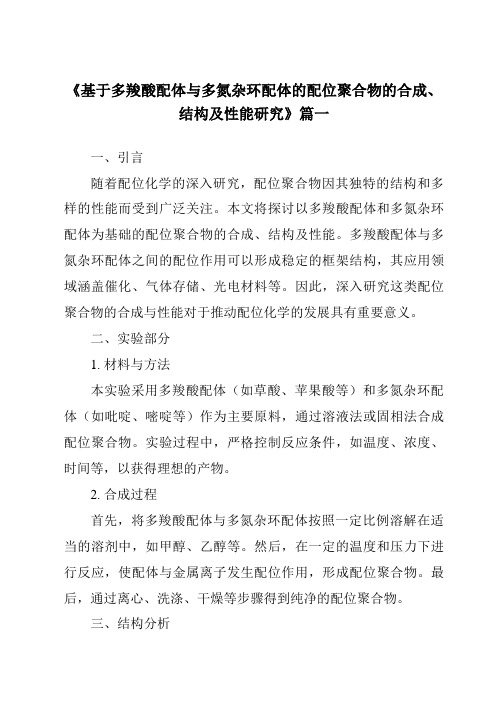
《基于多羧酸配体与多氮杂环配体的配位聚合物的合成、结构及性能研究》篇一一、引言随着配位化学的深入研究,配位聚合物因其独特的结构和多样的性能而受到广泛关注。
本文将探讨以多羧酸配体和多氮杂环配体为基础的配位聚合物的合成、结构及性能。
多羧酸配体与多氮杂环配体之间的配位作用可以形成稳定的框架结构,其应用领域涵盖催化、气体存储、光电材料等。
因此,深入研究这类配位聚合物的合成与性能对于推动配位化学的发展具有重要意义。
二、实验部分1. 材料与方法本实验采用多羧酸配体(如草酸、苹果酸等)和多氮杂环配体(如吡啶、嘧啶等)作为主要原料,通过溶液法或固相法合成配位聚合物。
实验过程中,严格控制反应条件,如温度、浓度、时间等,以获得理想的产物。
2. 合成过程首先,将多羧酸配体与多氮杂环配体按照一定比例溶解在适当的溶剂中,如甲醇、乙醇等。
然后,在一定的温度和压力下进行反应,使配体与金属离子发生配位作用,形成配位聚合物。
最后,通过离心、洗涤、干燥等步骤得到纯净的配位聚合物。
三、结构分析1. 晶体结构解析采用X射线单晶衍射技术对合成的配位聚合物进行晶体结构解析。
通过分析衍射数据,可以得到配位聚合物的三维空间结构、配位方式、键长、键角等信息。
这些信息有助于我们了解配位聚合物的结构特点及性能。
2. 结构表征利用红外光谱、紫外光谱、核磁共振等技术对配位聚合物进行结构表征。
这些技术可以提供关于配位聚合物的官能团、化学键、空间构型等信息,有助于我们更全面地了解其结构特点。
四、性能研究1. 光学性能通过紫外-可见光谱和荧光光谱研究配位聚合物的光学性能。
分析其吸收光谱、发射光谱等数据,了解其光吸收、发光等性质。
这些性质在光电材料、光催化等领域具有潜在的应用价值。
2. 热稳定性采用热重分析技术研究配位聚合物的热稳定性。
通过分析其在不同温度下的质量变化,了解其热分解过程及热稳定性能。
这对于评估其在高温环境中的应用具有重要意义。
3. 催化性能将配位聚合物应用于催化反应中,研究其催化性能。
多羧酸杂氮钌(Ⅱ)配合物的研究
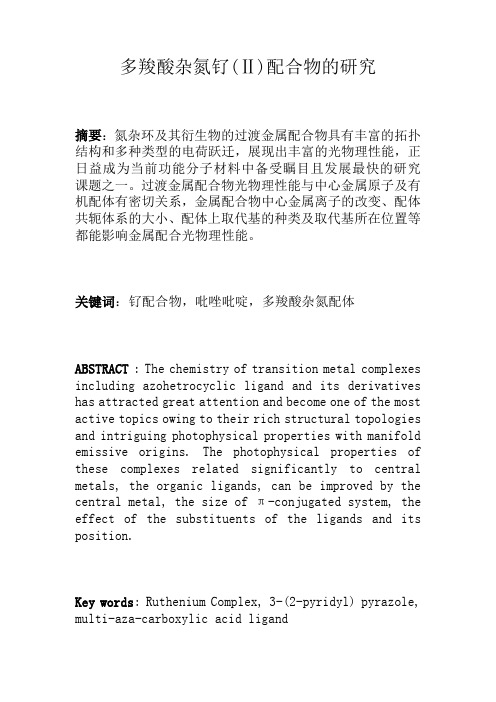
多羧酸杂氮钌(Ⅱ)配合物的研究摘要:氮杂环及其衍生物的过渡金属配合物具有丰富的拓扑结构和多种类型的电荷跃迁,展现出丰富的光物理性能,正日益成为当前功能分子材料中备受瞩目且发展最快的研究课题之一。
过渡金属配合物光物理性能与中心金属原子及有机配体有密切关系,金属配合物中心金属离子的改变、配体共轭体系的大小、配体上取代基的种类及取代基所在位置等都能影响金属配合光物理性能。
关键词:钌配合物,吡唑吡啶,多羧酸杂氮配体ABSTRACT : The chemistry of transition metal complexes including azohetrocyclic ligand and its derivatives has attracted great attention and become one of the most active topics owing to their rich structural topologies and intriguing photophysical properties with manifold emissive origins. The photophysical properties of these complexes related significantly to central metals, the organic ligands, can be improved by the central metal, the size of π-conjugated system, the effect of the substituents of the ligands and its position.Key words: Ruthenium Complex, 3-(2-pyridyl) pyrazole, multi-aza-carboxylic acid ligand1.1引言近年来,围绕具有一定器件功能的体系、光合作用模拟等方面的研究已取得了长足进展[1],其中过渡金属配合物作为电致发光材料在电致发光器件上的应用使有机电致发光的效率得到巨大的突破[2],说明过渡金属发光配合物的研究在具有重要基础理论意义的同时也具有巨大的实用价值。
一种新型氧化还原活性的配体合成、表征及电化学性质
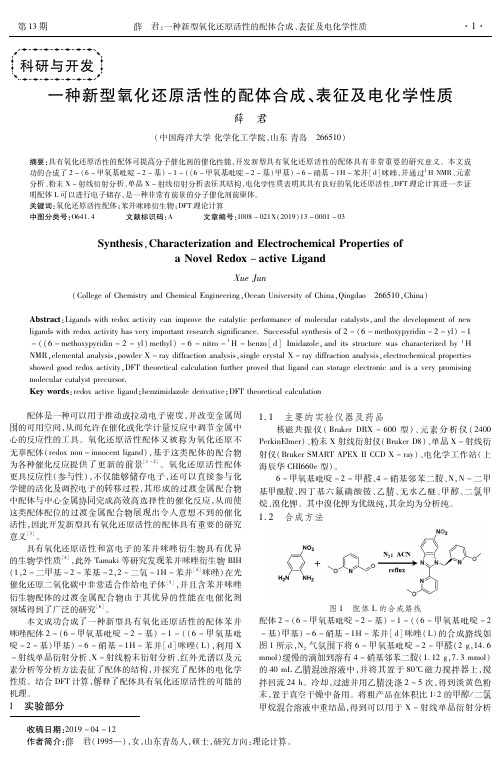
配体是一种可以用于推动或拉动电子密度,并改变金属周 围的可用空间,从而允许在催化或化学计量反应中调节金属中 心的反应性的工具。氧化还原活性配体又被称为氧化还原不 无辜配体(redoxnon-innocentligand),基于这类配体的配合物 为各种催化反应提供了更新的前景 。 [1-2] 氧化还原活性配体 更具反应性(参与性),不仅能够储存电子,还可以直接参与化 学键的活化及调控电子的转移过程,其形成的过渡金属配合物 中配体与中心金属协同完成高效高选择性的催化反应,从而使 这类配体配位的过渡金属配合物展现出令人意想不到的催化 活性,因此开发新型具有氧化还原活性的配体具有重要的研究 意义[3]。
6-甲氧基吡啶 -2-甲醛、4-硝基邻苯二胺、N,N-二甲 基甲酰胺、四 丁 基 六 氟 磷 酸 铵、乙 腈、无 水 乙 醚、甲 醇、二 氯 甲 烷、溴化钾。其中溴化钾为优级纯,其余均为分析纯。
1.2 合成方法
图 1 配体 L的合成路线 配体 2-(6-甲氧基吡啶 -2-基)-1-((6-甲氧基吡啶 -2 -基)甲基)-6-硝基 -1H-苯并[d]咪唑(L)的合成路线如 图 1所示,N2气氛围下将 6-甲氧基吡啶 -2-甲醛(2g,14.6 mmol)缓慢的滴加到溶有 4-硝基邻苯二胺(1.12g,7.3mmol) 的 40mL乙腈混浊溶液中,并将其置于 80℃磁力搅拌器上,搅 拌回流 24h。冷却,过滤并用乙腈洗涤 2~5次,得到淡黄色粉 末,置于真空干燥中备用。将粗产品在体积比 1∶2的甲醇 /二氯 甲烷混合溶液中重结晶,得到可以用于 X-射线单晶衍射分析
Synthesis,CharacterizationandElectrochemicalPropertiesof aNovelRedox-activeLigand
过渡金属配合物的合成、性质及生物活性研究
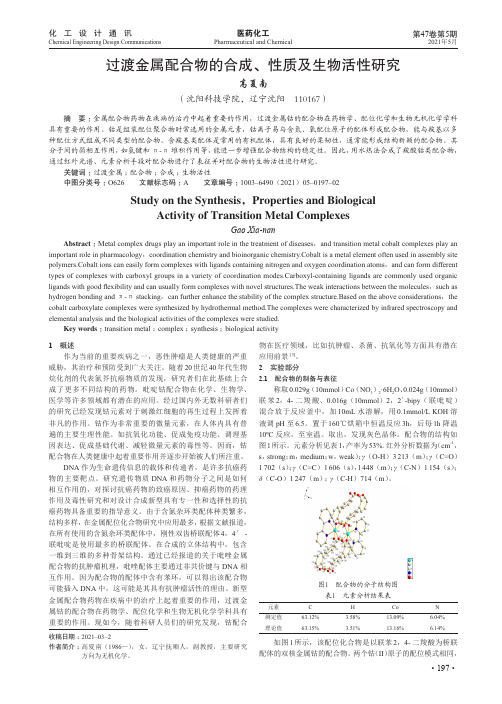
医药化工化 工 设 计 通 讯Pharmaceutical and ChemicalChemical Engineering Design Communications·197·第47卷第5期2021年5月1 概述作为当前的重要疾病之一,恶性肿瘤是人类健康的严重威胁,其治疗和预防受到广大关注。
随着20世纪40年代生物烷化剂的代表氮芥抗癌物质的发现,研究者们在此基础上合成了更多不同结构的药物。
吡啶钴配合物在化学、生物学、医学等许多领域都有潜在的应用。
经过国内外无数科研者们的研究已经发现钴元素对于刺激红细胞的再生过程上发挥着非凡的作用。
钴作为非常重要的微量元素,在人体内具有普遍的主要生理性能。
如抗氧化功能、促成免疫功能、调理基因表达、促成基础代谢、减轻微量元素的毒性等。
因而,钴配合物在人类健康中起着重要作用并逐步开始被人们所注重。
DNA 作为生命遗传信息的载体和传递者,是许多抗癌药物的主要靶点。
研究遗传物质DNA 和药物分子之间是如何相互作用的,对探讨抗癌药物的致癌原因、抑癌药物的药理作用及毒性研究和对设计合成新型具有专一性和选择性的抗癌药物具备重要的指导意义。
由于含氮杂环类配体种类繁多,结构多样,在金属配位化合物研究中应用最多,根据文献报道,在所有使用的含氮杂环类配体中,刚性双齿桥联配体4,4′-联吡啶是使用最多的桥联配体。
在合成的立体结构中,包含一维到三维的多种骨架结构。
通过已经报道的关于吡唑金属配合物的抗肿瘤机理,吡唑配体主要通过非共价键与DNA 相互作用。
因为配合物的配体中含有苯环,可以得出该配合物可能插入DNA 中,这可能是其具有抗肿瘤活性的理由。
新型金属配合物药物在疾病中的治疗上起着重要的作用,过渡金属钴的配合物在药物学、配位化学和生物无机化学学科具有重要的作用。
现如今,随着科研人员们的研究发现,钴配合物在医疗领域,比如抗肿瘤、杀菌、抗氧化等方面具有潜在应用前景[3]。
二三羧基羧酸与金属离子形成稳定络合物例子
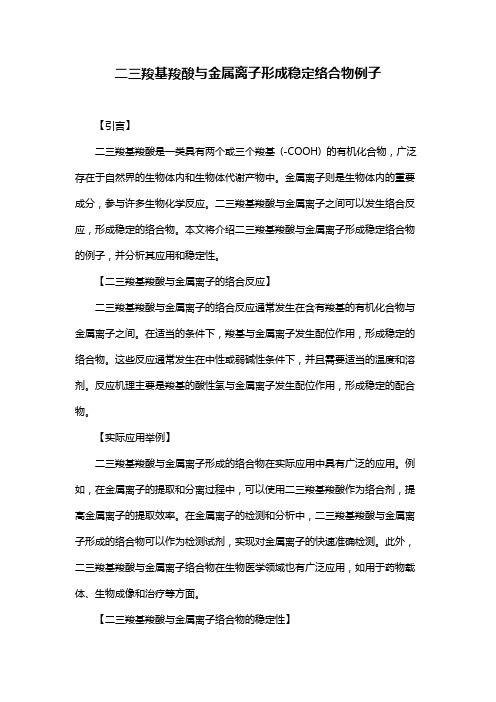
二三羧基羧酸与金属离子形成稳定络合物例子【引言】二三羧基羧酸是一类具有两个或三个羧基(-COOH) 的有机化合物,广泛存在于自然界的生物体内和生物体代谢产物中。
金属离子则是生物体内的重要成分,参与许多生物化学反应。
二三羧基羧酸与金属离子之间可以发生络合反应,形成稳定的络合物。
本文将介绍二三羧基羧酸与金属离子形成稳定络合物的例子,并分析其应用和稳定性。
【二三羧基羧酸与金属离子的络合反应】二三羧基羧酸与金属离子的络合反应通常发生在含有羧基的有机化合物与金属离子之间。
在适当的条件下,羧基与金属离子发生配位作用,形成稳定的络合物。
这些反应通常发生在中性或弱碱性条件下,并且需要适当的温度和溶剂。
反应机理主要是羧基的酸性氢与金属离子发生配位作用,形成稳定的配合物。
【实际应用举例】二三羧基羧酸与金属离子形成的络合物在实际应用中具有广泛的应用。
例如,在金属离子的提取和分离过程中,可以使用二三羧基羧酸作为络合剂,提高金属离子的提取效率。
在金属离子的检测和分析中,二三羧基羧酸与金属离子形成的络合物可以作为检测试剂,实现对金属离子的快速准确检测。
此外,二三羧基羧酸与金属离子络合物在生物医学领域也有广泛应用,如用于药物载体、生物成像和治疗等方面。
【二三羧基羧酸与金属离子络合物的稳定性】二三羧基羧酸与金属离子形成的络合物的稳定性主要与络合物的结构、反应条件和功能团有关。
通常情况下,稳定的络合物具有较紧密的配位结构,适当的反应条件以及具有较高稳定性的功能团。
在不同的应用领域,对络合物稳定性的要求也有所不同。
例如,在生物医学领域,要求络合物具有较高的生物稳定性和生物相容性。
【结论】二三羧基羧酸与金属离子形成的稳定络合物在许多领域具有广泛的应用,如金属离子的提取、分离、检测、分析和生物医学应用等。
然而,不同的应用领域对络合物的稳定性要求不同,因此在设计和应用络合物时需要充分考虑这些因素。
过渡金属催化合成杂环化合物的机理研究

过渡金属催化合成杂环化合物的机理研究过渡金属催化合成杂环化合物是有机合成领域的一项重要研究课题,催化剂中的过渡金属元素能够有效地促进反应的进行,从而高效地合成出杂环化合物。
在这篇文章中,我们将探讨过渡金属催化合成杂环化合物的机理研究。
首先,需要了解什么是过渡金属催化反应。
过渡金属是指周期表中位于d区的元素,它们具有较多的未配对电子,因此可以形成较稳定的配合物。
在催化反应中,过渡金属催化剂能够与底物发生相互作用,参与反应,提高反应速率,降低反应活化能。
这种催化反应在有机合成中有着广泛应用,尤其在杂环化合物合成中具有重要意义。
催化反应的机理研究对于优化催化反应条件、提高催化效率至关重要。
在过渡金属催化合成杂环化合物的反应中,常见的机理包括配位活化机理、氧化加氢机理以及亲电加成机理等。
首先,我们来讨论配位活化机理。
在这种机理中,过渡金属催化剂与底物形成配合物,通过主配体和辅配体的协同作用,实现底物的活化和转化。
配合物的形成能够改变底物的活性,使其更易于发生反应。
例如,在过渡金属催化的碳-碳偶联反应中,过渡金属配合物能够与底物形成稳定的中间体,使其更容易发生炭素原子的偶联。
其次,氧化加氢机理也是过渡金属催化合成杂环化合物中常见的机理。
该机理主要包括氧化和加氢两个步骤。
过渡金属催化剂能够在反应中接受或捐赠氧、氢原子,实现底物的氧化或加氢反应。
例如,在过渡金属催化的醛缩反应中,过渡金属催化剂能够将醛氧化为羧酸,或将醛还原为醇,从而形成杂环化合物。
最后,亲电加成机理也是过渡金属催化合成杂环化合物的重要机理之一。
亲电加成是指亲电试剂通过配位或氧化加成到底物上,形成新的碳-碳或碳-氮键。
过渡金属催化剂能够作为催化剂参与亲电加成反应,提供亲电试剂与底物之间的接触点,促进反应进行。
例如,在过渡金属催化的氰基化反应中,过渡金属催化剂能够将氰基试剂加成到底物上,形成羧酰胺结构。
除了上述机理,还有其他一些复杂的机理和过渡态可以被观察到。
羧酸类小分子合成配位催化剂的研究

}
2o oO Wte ule・/ m  ̄ nn l c v b s
图 1 配位催 化剂红外光谱 图
22 催化剂 降解 萘酚 绿 B的实验 研究 .
取出用高速离心 机离心 , 去上 清液在 20~ 0 n 0 80 m 范围内扫描紫外吸收光谱 , 如图 2 图 3 , 所示。
( )水浴法 1
3 % 的 H: 其 中一 支 不 加 催 化 剂 作 为 试 剂 空 白, 0 0, 另外 一 支 加 入 催 化 剂 , 匀 , 微 波 功率 30 和 摇 在 0W 6  ̄下 , 0C 进行 微 波照 射水 样 实验 反 应 3 n 以蒸馏 mi。
水 为参 比 , 1 m 石英 比色 皿 , 最 大 吸 收 波 长处 用 c 在
计合成了一种 以羧酸类小分子和过渡金属为原料合成配位催化剂 , 并对其产物进行 了红外表征和催化作用的研究 。
关键词 : 羧酸; 配合物 ; 合成 ; 催化降解
中图分类号: Q 2 . T 466 文献标识码 : A 文章编号 :0 8—0 1 2 1 )9- 0 8—0 10 2 X(0 2 0 0 0 3
二 ×10 0 %。
^ 0
7 77m 4 .c 的吸收峰归属为 13 5一 , , 三取代的定位 峰【 。通过这些官能团的表征 , 4 】 确定合成产物是 目
标产 物 。
75 . 7O ・ 65 ・
薹. 6 0
55 - 50 . 45 ・ 40 .
3 O ,
萘 酚绿 B 的最 大 吸收 波 长 是 7 6m。从 图 2 1n ,
22 1 不同方法降解萘酚绿 B紫外 一 .. 可见吸收光
谱对 比实验
按照实验方法 , 移取萘酚绿 B溶液 到 3个 圆底
- 1、下载文档前请自行甄别文档内容的完整性,平台不提供额外的编辑、内容补充、找答案等附加服务。
- 2、"仅部分预览"的文档,不可在线预览部分如存在完整性等问题,可反馈申请退款(可完整预览的文档不适用该条件!)。
- 3、如文档侵犯您的权益,请联系客服反馈,我们会尽快为您处理(人工客服工作时间:9:00-18:30)。
摘要摘要配位聚合物作为一种新型的分子功能材料,凭借其独特的结构可剪裁性、多样的拓扑结构和在离子交换、吸附、分子识别、催化以及光、点磁、手性拆分等领域的巨大应用潜力受到各界科学家们越来越多的关注。
羧酸配合物和配位聚合物具有性质独特、结构多样化、不寻常的性质等特点,它们在非线性光学材料、磁性材料、催化材料、分子载体、存储气体、生物工程等诸多领域具有广泛的应用前景。
因此,对羧酸配合物和配位聚合物的研究具有理论意义和潜在应用价值。
本文主要的研究内容为过渡金属Cu、Cd的金属盐与内型降冰片烯-顺5.6-二羧酸反应为配体邻菲罗啉、2,2-联吡啶为辅助配体在相同温度下反应构筑出具有新颖拓扑结构的金属—有机配位聚合物的相关反应进行研究。
关键词:二羧酸铜配合物,二羧酸镉配合物,合成,晶体结构IABSTRACTABSTRACTPolymer as a novel molecular functional materials, by virtue of its unique structure, building materials of various topologies and in ion exchange, adsorption, molecular recognition, catalytic and optical, magnetic, chiral resolution field potential application is more and more attention from all walks of life scientists. Carboxylic acid complexes and coordination polymers with unique properties, structural diversification, unusual characters, they are in nonlinear optical materials, magnetic materials, catalytic materials, molecular carrier, gas storage, biological engineering and other fields have broad application prospects. Therefore, the carboxylic acid complexes and coordination polymers research has theoretical significance and potential application value.The main research contents of this article as transition metals Cu, Cd metal salt and type of norbornene and endo-norbornene-cis-5,6-dicarboxylate anion response to ligand phenanthroline,2,2 - bipyridine as assistant ligand at the same temperature response to build a novel topological structure of metal organic coordination polymers related reactions research.Key words:acid Copper Complex, acid cadmium complex, synthesis, crystal structureII目录目录1引言--------------------------------------------------------------1 2实验准备----------------------------------------------------------3 2.1仪器-------------------------------------------------------------3 2.2试剂-------------------------------------------------------------3 3实验部分----------------------------------------------------------4 3.1内型降2.2.冰片烯-顺5.6-二羧酸----------------------------------4 3.2 配合物的合成----------------------------------------------------5 3.3红外光谱测定-----------------------------------------------------7 3.4 X-射线衍射分析-------------------------------------------------7 4结果与讨论------------------------------------------------------10 4.1配位聚合物晶体的培养方法---------------------------------------10 4.2配合物晶体的合成与分析------------------------------------------11 5结论-------------------------------------------------------------12 参考文献-----------------------------------------------------------14 致谢---------------------------------------------------------------13III1 引言配位化学是由无机化学延伸发展出来的一门边缘学科,研究的主要对象为配位化合物(Coordination Compounds,简称配合物)。
早期的配位化学研究集中在以金属阳离子受体为中心(作为酸)和以含N、O、S、P等给体原子的配体(作为碱)而形成的所谓“Wemer配合物”。
当代赔配位化学发展更是日新月异、飞速发展,其发展方向主要沿着深度、广度和应用三个方向进行。
尽管“超分子”(Supramolecule)早在上世纪三十年代就被用来描述由配位饱和的物种聚集而成的高度有序的复杂体。
超分子化学的基本概念、术语和定义在上世纪七十年代也被介绍过[1-2],然而对超分子化学做出全面概述的是在1987年诺贝尔颁奖礼上J.M.Lehn所发表的以“超分子化学”为题的演说。
超分子化学,是研究分子间相互作用缔结而形成复杂有序且具有特定功能的分子聚集体的科学这种分子聚集体简称超分子。
换言之是研究通过非共价键作用形成功能体系的超分子科学[3-4]。
由于超分子在磁学、分子识别、光学、电学和催化等领域里具有巨大的应用潜力,设计合成新型功能超分子化合物是当今晶体工程学、配位化学、超分子化学等领域的研究热点之一[5]。
在此基础上衍生了一个新的研究领域:金属—有机配位聚合物(MOPC),该领域的研究内容上具有高度的科学交叉性,涉及到物理化学(对非共价键作用的实验和理论研究)、有机化学(通过有机合成方法构造受体)、生物化学(所有底物识别、键合的开始过程)和无机化学(有机配体与金属结构合成配合物)。
MOPC以有机分子和无机离子为反应材料,它们之间的相互作用被利用形成无限延伸的一维、二维或三维高级有序结构,并通过物理化学的手段对其性能进行研究。
由于无机离子结构的修饰和改造难度很大,难以根据实际需要来控制其物理化学特性、大小以及形状。
有机化合物则有优良的修饰与分子裁剪的功能,但它们在稳定性和坚固性等方面具有明显缺点。
因此我们将有机化合物和无机金属离子两者互补的结合起来,构筑结构稳定、坚固、可塑的新型具有诱人前景的MOPC[6]。
由于有繁多羧酸配体种类,且羧酸配体极易和金属盐发生反应,因此它在1配位化学中占有着重要地位[7]。
羧酸作为配体时,将金属配合物引入到杂多体系中,极大地丰富了基于POM的杂化材料。
在这类杂化材料中,含N或含O的有机配体先同金属离子配位,而金属离子再利用剩余的配位点同金属-氧簇骨架上的氧配位。
通过调节金属中心的组成及其氧化态来改善富氧的多酸表面,使表面氧原子活化,从而形成帽状多金属氧酸盐[8]。
我们选用四水硝酸镉、无水氯化铜与内型降冰片烯-顺5.6-二羧酸反应为配体邻菲罗啉、2,2-联吡啶为辅助配体在不同温度下反应构筑出金属—有机配位聚合物。
金属—有机配位聚合物在现实生活中具有广泛的应用,而羧酸配合物由于它性质的独特性、结构的多样性使它在生物工程、催化材料、光学材料、分子载体、存储气体、磁性材料等领域具有广泛前景。
22 实验准备2.1 仪器:X-射线衍射仪双目显微熔点仪真空干燥箱红外光谱仪电子天平恒温磁力搅拌器循环水式多用真空泵 100ml圆底烧瓶回流冷凝管 15mL试管抽气泵抽滤瓶铁架台集热式恒温加热磁力搅拌器2.2试剂邻菲罗啉甲醇无水乙醇2,2-联吡啶无水氯化铜二氯甲烷三氯甲烷四水硝酸镉甲苯丙酮乙酸铜其它试剂均为分析纯33 实验部分3.1 内型降冰片烯-顺5.6-二羧酸的合成(1)在100ml 圆底烧瓶中加入20ml 环戊二烯二聚体,在170~190℃油浴(或电热套)中裂解和蒸馏。
保持馏分的出口温度为40~45℃。
蒸馏1~2 小时,得到双环戊二烯热裂解(逆Diels-Alder)产物环戊二烯。
双环戊二烯热裂解(逆Diels-Alder)反应装置示意图(2)取8ml 的环戊二烯加入100ml 圆底烧瓶中,将该圆底烧瓶放在冰水浴中。
(3)用电子天平准确称量7.6353g 的顺丁烯二酸酐倒入100ml 的锥形瓶中,然后加入30ml 乙酸乙酯使其溶解。
(4)将步骤(3)中的溶液倒入冰水浴中步骤(2)中的圆底烧瓶中,在室温下搅拌。
有白色的固体析出。
(5)将步骤(4)中的圆底烧瓶放在50℃的油浴中加热搅拌,直到白色固体全部溶解。
然后让其在室温下自然冷却。
得到透明的白色针状晶体。
(6)用布氏漏斗抽滤除去溶剂,得到透明的白色针状晶体。
在真空干燥箱中干燥,得到白色的针状晶体,记录白色针状晶体的质量。
45反应方程3.2 配合物的合成3.2.1 合成配合物A(1)将0.27克的溶于无水乙醇的无水氯化铜滴加入0.36克的内型降冰片烯-顺5.6-二羧酸的无水乙醇溶液中,并在80℃条件下回流4小时。
